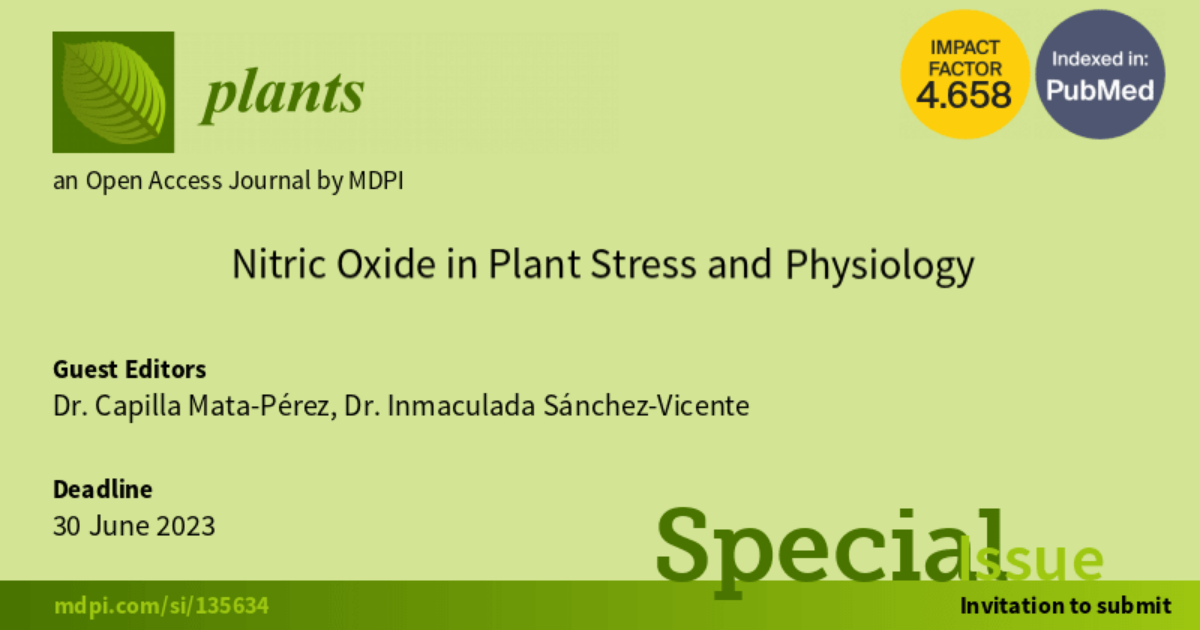- 4.1Impact Factor
- 7.6CiteScore
- 18 daysTime to First Decision
Nitric Oxide in Plant Stress and Physiology
This special issue belongs to the section “Plant Physiology and Metabolism“.
Special Issue Information
Dear Colleagues,
Nitric oxide (NO) has evolved as a key gasotransmitter in living systems. A growing number of investigations have shown the significance of NO in the regulation of developmental processes and in the response against (a)biotic processes. Indeed, it is involved in the maintenance of cellular homeostasis readjusting the redox state of multiple targets that tailor adaptive response to changing conditions. NO can modify a great variety of biomolecules, including nucleic acids, proteins, and fatty acids. Consequently, these modifications can lead to a biochemical reprogramming that impacts plant growth and how plants can respond to stressful situations.
This Special Issue of Plants will gather articles converging on the study of the effects and molecular mechanisms underlying stress physiology responses mediated by nitric oxide.
Dr. Capilla Mata-Pérez
Dr. Inmaculada Sánchez-Vicente
Guest Editors
Manuscript Submission Information
Manuscripts should be submitted online at www.mdpi.com by registering and logging in to this website. Once you are registered, click here to go to the submission form. Manuscripts can be submitted until the deadline. All submissions that pass pre-check are peer-reviewed. Accepted papers will be published continuously in the journal (as soon as accepted) and will be listed together on the special issue website. Research articles, review articles as well as short communications are invited. For planned papers, a title and short abstract (about 250 words) can be sent to the Editorial Office for assessment.
Submitted manuscripts should not have been published previously, nor be under consideration for publication elsewhere (except conference proceedings papers). All manuscripts are thoroughly refereed through a single-blind peer-review process. A guide for authors and other relevant information for submission of manuscripts is available on the Instructions for Authors page. Plants is an international peer-reviewed open access semimonthly journal published by MDPI.
Please visit the Instructions for Authors page before submitting a manuscript. The Article Processing Charge (APC) for publication in this open access journal is 2700 CHF (Swiss Francs). Submitted papers should be well formatted and use good English. Authors may use MDPI's English editing service prior to publication or during author revisions.
Keywords
- nitric oxide
- NO signaling
- post-translational modifications
- gene expression
- protein nitration
- S-nitrosylation
- fatty acid nitration
- nitroalkylation
- denitrosylation
- plant development
- abiotic stress
- biotic stress
- reactive nitrogen species
- redox signaling
- germination
- senescence

Benefits of Publishing in a Special Issue
- Ease of navigation: Grouping papers by topic helps scholars navigate broad scope journals more efficiently.
- Greater discoverability: Special Issues support the reach and impact of scientific research. Articles in Special Issues are more discoverable and cited more frequently.
- Expansion of research network: Special Issues facilitate connections among authors, fostering scientific collaborations.
- External promotion: Articles in Special Issues are often promoted through the journal's social media, increasing their visibility.
- e-Book format: Special Issues with more than 10 articles can be published as dedicated e-books, ensuring wide and rapid dissemination.

